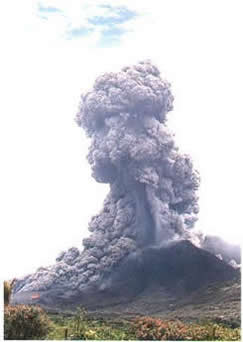Volcano Learning Zone
All the volcano facts and info you need.
Need help with your volcano project? The Volcanic Photo Glossary has 95 volcanic terms, all illustrated .
All the types of volcano and volcanic eruption. Plus a famous volcanic eruption case study section, including Mt St Helens and Montserrat . In Plate tectonics learn how the movement of plates causes volcanoes.
Volcanic hazards such as pyroclastic flows,lahars and ash clouds and how people manage volcanic hazards.
Top 20 volcano questions answered Full List here
 A volcano is an opening in the earths crust, known as a vent, through which molten rock, ash and gases are erupted onto the earths surface.Volcanoes can erupt onto land or beneath the sea.
A volcano is an opening in the earths crust, known as a vent, through which molten rock, ash and gases are erupted onto the earths surface.Volcanoes can erupt onto land or beneath the sea.
More on
Why do people live near volcanoes
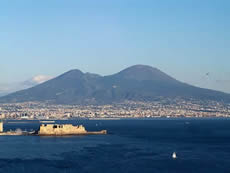 500 million people live near volcanoes. Major cities such as Naples, Mexico City and Seattle are all in the shadow of potentially dangerous eruptions .
500 million people live near volcanoes. Major cities such as Naples, Mexico City and Seattle are all in the shadow of potentially dangerous eruptions .
Why? More here
Can we predict volcanic eruptions?
95 Volcano Terms described, explained and illustrated. Volcano Terms and Picture Glossary.
PahoehoePahoehoe is a form of basaltic lava flow. The term comes from an Hawaiian word which means smooth or rope like.Pahoe hoe lava is composed of basalt ,is very fluid and has a temperature of 1200C.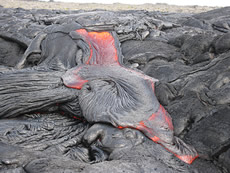
Hot Spot
Pyroclastic flow
Volcanic Bomb
More in the Volcano Glossary
All clearly explained and illustrated.
Volcano facts and figures. Top tens of Volcanoes
More here
How many volcanoes are there in the world?
How many volcanoes do we know about and how many are erupting at the minute. Find out here
The largest volcanic eruptions
The largest eruption in recorded history is of Tambora in 1815.The largest pre hstory we know of is
More largest eruptions: recorded history / prehistory
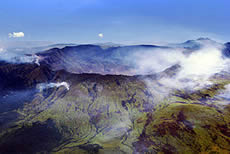
Which is the tallest volcano?
Mauna Kea or Ojos del Salado.
Find out here
What is the most active volcano?
Kilauea or Stromboli?Find out here
The most dangerous volcano?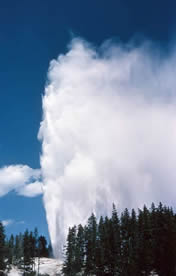
Vesuvius,Merapi,Yellowstone?
Find out here.
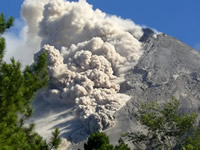 The the standard view of a volcano is a perfect cone erupting ash from a summit crater with rivers of lava flowing down the slopes.In reality there are a variety of volcano types.Steep sided cones are characteristic of stratovolcanoes,Shield volcanoes have gentle slopes formed by basaltic lava flows.Magma and lava type is the main factor in causing the shape and eruptive style of a volcano.More on Types of Volcano
The the standard view of a volcano is a perfect cone erupting ash from a summit crater with rivers of lava flowing down the slopes.In reality there are a variety of volcano types.Steep sided cones are characteristic of stratovolcanoes,Shield volcanoes have gentle slopes formed by basaltic lava flows.Magma and lava type is the main factor in causing the shape and eruptive style of a volcano.More on Types of Volcano
Shield volcano Stratovolcano Cinder Cone Lava Dome Supervolcano/ Caldera eruption Rift / Fissure eruption
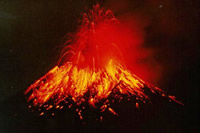 Volcanoes erupt in different styles from flowing rivers of lava in Hawaii to dramatic and violent explosions on Montserrat. So how do volcanoes erupt? and Why can the eruptions be so different?
Volcanoes have different eruption styles caused by magma type and explosivity.
Volcanoes erupt in different styles from flowing rivers of lava in Hawaii to dramatic and violent explosions on Montserrat. So how do volcanoes erupt? and Why can the eruptions be so different?
Volcanoes have different eruption styles caused by magma type and explosivity.
More on Types of Volcanic Eruption
What is Plate Tectonics?
Plate Tectonics explains how the earths crust is split into large rigid slabs of rock called tectonic plates. The slabs are the cooled outer layer of the earth and beneath them the lies the mantle, a very hot layer of rock on which the plates float.
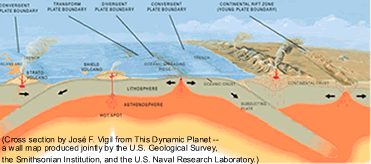
There are two types of plate Oceanic and Continental. The plates move over the mantle and at where they meet volcanoes and earthquakes are likely to occur. Subduction occurs where a oceanic plate sinks beneath another plate, this can produce spectacular and dangerous volcanic eruptions.
 Volcanic rocks are the eruptive equivalent of magma from within the volcano.When the magma is erupted onto the earths crust they then become extrusive or volcanic. The composition of the rocks above and below the surface is the same but mode of eruption and speed of cooling creates different a classification or rock type. The chemicals composition of the magma will determine whether the eruption is explosive or effusive.
Volcanic rocks are the eruptive equivalent of magma from within the volcano.When the magma is erupted onto the earths crust they then become extrusive or volcanic. The composition of the rocks above and below the surface is the same but mode of eruption and speed of cooling creates different a classification or rock type. The chemicals composition of the magma will determine whether the eruption is explosive or effusive.
Volcanic rocks are often formed in spectacular ways. Lava flows,pyroclastic flows,volcanic bombs and ash all form volcanic rocks. Rhyolite, Andesite and Basalt are types of lava.
But what are volcanic rocks made of? What makes lava flow or volcanoes explode? Find out about Volcanic Rock Types
Volcanic Hazards include pyroclastic flows,lahars,lava flows,tsunami,ash clouds and earthquakes and can be dramatic,deadly and rapid.
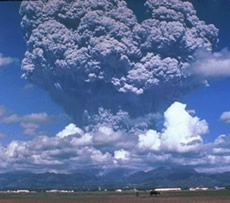
Lava Flows
Lahars
Ash clouds
pyroclastic flows
Volcanic monitoring/prediction
Volcanic hazard management
More on Volcanic Hazards







